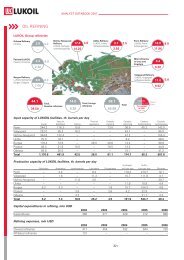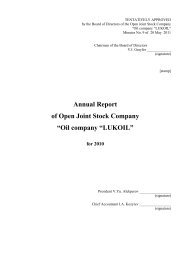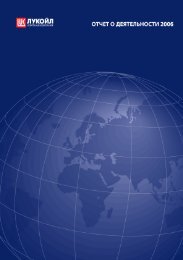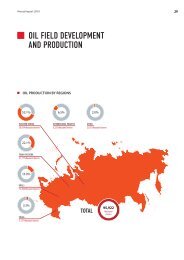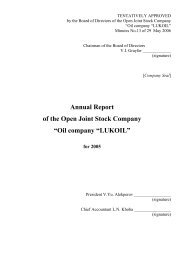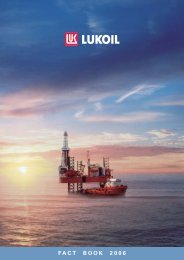ANNUAL REPORT 2005 - Lukoil
ANNUAL REPORT 2005 - Lukoil
ANNUAL REPORT 2005 - Lukoil
You also want an ePaper? Increase the reach of your titles
YUMPU automatically turns print PDFs into web optimized ePapers that Google loves.
FINANCIAL ACCOUNTS<br />
Property, plant and equipment<br />
Oil and gas properties are accounted for using the successful efforts method of accounting whereby property acquisitions,<br />
successful exploratory wells, all development costs, and support equipment and facilities are capitalized.<br />
Unsuccessful exploratory wells are expensed when a well is determined to be non-productive. Other exploratory expenditures,<br />
including geological and geophysical costs are expensed as incurred.<br />
Depreciation, depletion and amortization of capitalized costs of oil and gas properties is calculated using the<br />
unit-of-production method based upon proved reserves for the cost of property acquisitions and proved developed<br />
reserves for exploration and development costs.<br />
Production and related overhead costs are expensed as incurred.<br />
Depreciation of assets not directly associated with oil production is calculated on a straight-line basis over the economic<br />
lives of such assets, estimated to be in the following ranges:<br />
Buildings and constructions 5 – 40 Years<br />
Machinery and equipment 5 – 20 Years<br />
In addition to production assets, certain Group companies also maintain and construct social assets for the use of local<br />
communities. Such assets are capitalized only to the extent that they are expected to result in future economic benefits<br />
to the Group. If capitalized, they are depreciated over their estimated economic lives.<br />
Goodwill and other intangible assets<br />
Goodwill represents the excess of the cost of an acquired entity over the net of the amounts assigned to assets acquired<br />
and liabilities assumed. It is assigned to reporting units as of the acquisition date. Goodwill is not amortized, but is<br />
tested for impairment at least on an annual basis and between annual tests if an event occurs or circumstances change<br />
that would more likely than not reduce the fair value of a reporting unit below its carrying amount. The impairment test<br />
requires estimating the fair value of a reporting unit and comparing it with its carrying amount, including goodwill<br />
assigned to the reporting unit. If the estimated fair value of the reporting unit is less than its net carrying amount, including<br />
goodwill, then the goodwill is written down to its implied fair value.<br />
Intangible assets with indefinite useful lives are tested for impairment at least annually. Intangible assets that have<br />
limited useful lives are amortized on a straight-line basis over the shorter of their useful or legal lives.<br />
Impairment of long-lived assets<br />
Long lived assets, such as oil and gas properties, other property, plant, and equipment, and purchased intangibles subject to<br />
amortization, are assessed for impairment whenever events or changes in circumstances indicate that the carrying amount<br />
of an asset group may not be recoverable. Recoverability of assets to be held and used is measured by a comparison of the<br />
carrying amount of an asset group to the estimated undiscounted future cash flows expected to be generated by that group.<br />
If the carrying amount of an asset group exceeds its estimated undiscounted future cash flows, an impairment charge is recognized<br />
by writing down the carrying amount to the estimated fair value of the asset group, generally determined as disco<br />
unted future net cash flows. Assets to be disposed of are separately presented in the balance sheet and reported at the lower<br />
of the carrying amount or fair value less costs to sell, and are no longer depreciated. The assets and liabilities of a disposed<br />
group classified as held for sale are presented separately in the appropriate asset and liability sections of the balance sheet.<br />
Deferred income taxes<br />
Deferred income tax assets and liabilities are recognized in respect of future tax consequences attributable to temporary<br />
differences between the carrying amounts of existing assets and liabilities for the purposes of the consolidated financial<br />
statements and their respective tax bases and in respect of operating loss and tax credit carryforwards. Deferred income<br />
tax assets and liabilities are measured using enacted tax rates expected to apply to taxable income in the years in which<br />
those temporary differences are expected to reverse and the assets be recovered and liabilities settled. The effect on<br />
deferred income tax assets and liabilities of a change in tax rates is recognized in the consolidated statement of income<br />
in the reporting period which includes the enactment date.<br />
The ultimate realization of deferred income tax assets is dependent upon the generation of future taxable income in the<br />
reporting periods in which the originating expenditure becomes deductible. In assessing the realizability of deferred<br />
income tax assets, management considers whether it is more likely than not that the deferred income tax assets will be<br />
realized. In making this assessment, management considers the scheduled reversal of deferred income tax liabilities,<br />
projected future taxable income, and tax planning strategies.<br />
Interest-bearing borrowings<br />
Interest-bearing borrowings are initially recorded at the value of net proceeds received. Any difference between the net<br />
proceeds and the redemption value is amortized at a constant rate over the term of the borrowing. Amortization is included<br />
in the consolidated statement of income each year and the carrying amounts are adjusted as amortization accumulates.<br />
142







